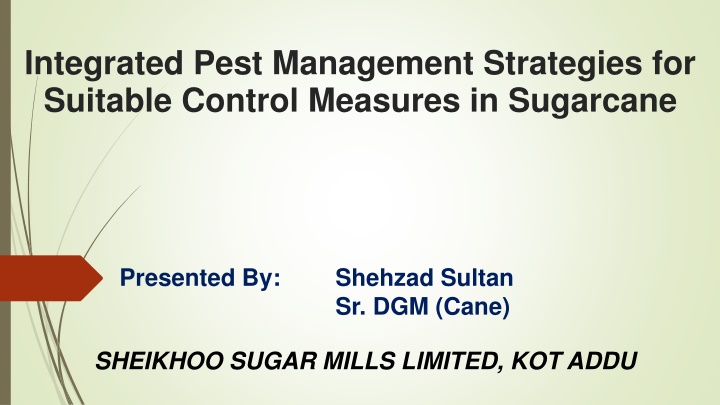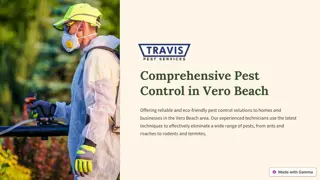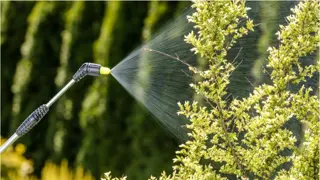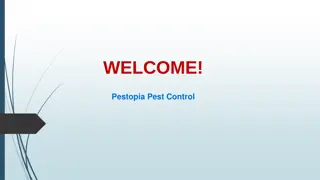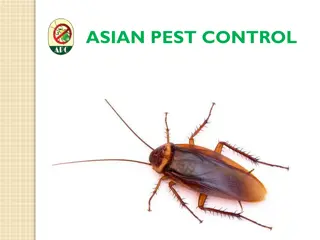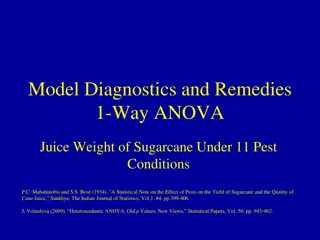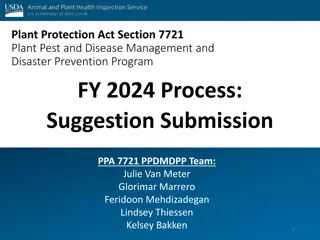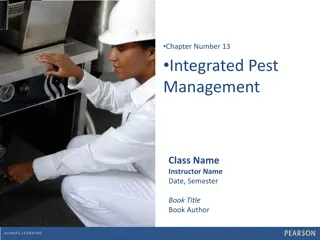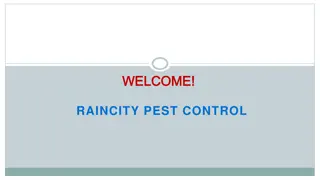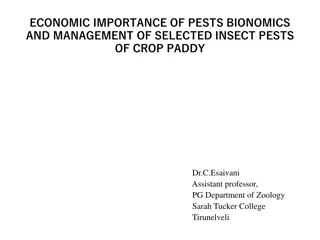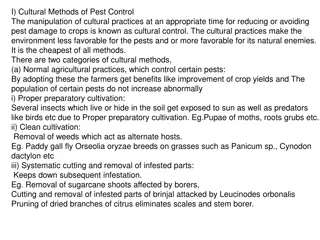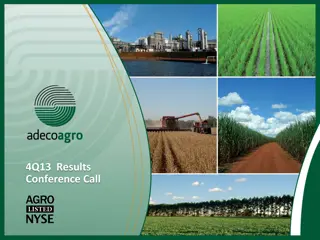Integrated Pest Management Strategies in Sugarcane for Sustainable Crop Production
The concept of Integrated Pest Management (IPM) in sugarcane production focuses on using a combination of techniques to manage pest populations sustainably. This approach considers the biology and behavior of pests and aims to reduce reliance on chemical pesticides while promoting environmentally-friendly pest control methods. Key components include monitoring, identification, prevention, cultural control, biological control, and chemical control. Implementing IPM in sugarcane involves monitoring pest populations, adopting good agricultural practices, utilizing biological control agents, and resorting to chemical control only as a last resort.
Download Presentation

Please find below an Image/Link to download the presentation.
The content on the website is provided AS IS for your information and personal use only. It may not be sold, licensed, or shared on other websites without obtaining consent from the author.If you encounter any issues during the download, it is possible that the publisher has removed the file from their server.
You are allowed to download the files provided on this website for personal or commercial use, subject to the condition that they are used lawfully. All files are the property of their respective owners.
The content on the website is provided AS IS for your information and personal use only. It may not be sold, licensed, or shared on other websites without obtaining consent from the author.
E N D
Presentation Transcript
Integrated Pest Management Strategies for Suitable Control Measures in Sugarcane Presented By: Shehzad Sultan Sr. DGM (Cane) SHEIKHOO SUGAR MILLS LIMITED, KOT ADDU
INTRODUCTION The increasing population of the world and increasing demands for food and other agricultural products. Insects are the largest and more diverse group of animals and found almost everywhere in the environment. Pests attack economically important plant parts resulting in the death or lower yield of the plant. The term integrated pest management (IPM) was synthesized and published by a number of authors who were gaining the awareness about the negative role of insecticides. This study will provide technical knowledge to the field staff and farmers for the implementation of IPM for sustainable production of sugarcane crop in Pakistan. Sugarcane Area (Hectare) 1,259,594 Production (tons) 88,615,674 Yield (Tons/ha) 70.35 Sugar Recovery (%) 9.87 (PSMA annual report, 2021-22) Year 2021-2022
WHAT IS INTEGRATED PEST MANAGEMENT (IPM)? Integrated Pest Management (IPM) is an approach to control pests that promotes the use of a combination of techniques to manage pest populations in a sustainable and environmentally-friendly manner. The IPM approach takes into account the biology and behavior of pests, as well as their interactions with the environment and surrounding ecosystem. IPM is an approach that is gaining popularity, particularly in the agriculture industry, as it reduces the reliance on chemical pesticides, which can have harmful effects on the environment, as well as on people and wildlife. The goal of IPM is to manage pests in a way that is effective, economically feasible, and sustainable in the long term.
Integrated Pest Management (IPM) Components MONITORING: Regular inspections to identify pests and determine their population levels. IDENTIFICATION: Accurately identifying the pest species, as well as their life cycle, behavior, and habitat. PREVENTION: Taking steps to prevent pest infestations, such as implementing good sanitation practices. CULTURAL CONTROL: Using practices that make the environment less favorable for pests, such as crop rotation or planting pest-resistant varieties. BIOLOGICAL CONTROL: Using natural enemies of pests, such as predators or parasites, to control populations. CHEMICAL CONTROL: Using pesticides when necessary, but only as a last resort.
Implementing IPM in Sugarcane The implementation of IPM in sugarcane production involves a holistic approach to control pests. Some of the key elements of an IPM program for sugarcane include: Monitoring (Pest Scouting): Regular monitoring of the sugarcane crop for signs of pest infestations, as well as tracking the population levels of pests. Prevention: Good agricultural practices, such as crop rotation and maintaining healthy soil, can help prevent pest infestations. Biological Control: The use of natural enemies of pests, such as predators and parasites, can be an effective way to control pest populations. Chemical Control: The use of chemical pesticides is only recommended when other methods have failed, and when the pesticide is deemed safe and effective.
Generation / Active Period of Sugarcane Borers No. of Generation in a year Name of Borer Active Period Top Borer 4-5 Feb-Nov Stem Borer 4-5 Mar-Nov Root Borer 3-4 Apr-Nov Gurdaspur Borer 2-3 Jul-Oct
ETL of Sugarcane Pest Name of Borer Top Borer Stem Borer Root Borer Gurdaspur Borer Pyrilla Mites Termites Mealy Bug Grasshopper (Tokka) White Fly Black Bug Roddents Economic Threshold Level 8-10% 8-10% 8-10% 8-10% 3 / Leaf 10 / Leaf 10% Damage 3-5 Adults On Appearance 10 / Leaf 10 / Sheeth 5 Live Burrows / Acre
Production Losses % Reduction in Cane Yield (tons/ha) 21-37 31-33 32-35 25-30 14.7 16-20 18-22 37-40 80 31 15-20 Reduction in Sugar Recovery % 0.2 - 4.1 1.7 3.07 0.3 2.9 0.3 2.1 2.0 3.0 0.2 1.3 2.7 - 4.5 2.1 4.3 1.4 1.8 0.1 2.8 0.1 1.1 Name of Pest Top Borer Stem Borer Root Borer Gurdaspur Borer Pyrilla Mites Termites Grasshopper (Tokka) White Fly Black Bug Roddents Reference: Sugarcane Pests & their Management (Srikanth, et. al., 2001)
Chemical Control of Sugarcane pests Name of Pest Chemical Top Borer Stem Borer Root Borer Gurdaspur Borer Termites Fipronil 25% Ec (60 gm / acre) Chlorantraniliprole 40wg (8 kg / acre) Bifenthrine 10% Ec (500 ml / acre) Cypermethrine 10% Ec (1L / acre) Lambda Cyhalothrine 2.5 % (1 L / acre) Profenofos 50% Ec (1200 ml / acre) Chloropyrifos 40% Ec (2 L / acre) Chewing Pest Grosshopper (Tokka) Fipronil 25% Ec (60 gm / acre) Chloropyrifos 40% Ec (2 L / acre) Obiron 24 Sc (300 ml / acre for Mites) Lambda Cyhalothrine 2.5 % (1 L / acre) Cypermethrin 10% Ec (1 L / acre) Bifenthrine 10% Ec (500 ml / acre) Aluminium phosphide Pyrilla Mites Mealy Bug White Fly Black Bug Rats, Pigs, Jackals Sucking Pest Roddents
Bio-control Agents Insects Biological agents Root borer Stem borer Gurdaspur borer Top borer Trichogramma chilonis-Egg parasite (20-25 cards/acre from March to September fortnightly) Only 40% control of top borer due to the covering with orange tuft of anal hairs of female. Tetrastichus pyrillae (Egg parasite naturally present). Epiricania (Predator-naturally present). Pyrilla White Fly Pyrilla Chrysoperla carnea-Predator (Green lacewing) Mealybug destroyer-Predator (Cryptolaemus montrouzieri) Mealybug
Parasites and Predators of Sugarcane Pests Coccinella septempunctera (Lady Bird Beetle) Trichogramma chilonis Epiricania melanoleuca Chrysopa sp.
Crop Stage Wise IPM in Sugarcane Management Pre-Sowing and after sowing Activity Soil test based nutrient recommendations should be followed for use of NPK. Apply organic manures/press mud @ 8 to 10 tons/acre Sugarcane trash can be used as a mulch. Spread trash with 20 Kg urea and 25 Kg SSP. Crops like jantar are grown as green manure crop. Cultural control: Adopt proper crop rotation & follow recommended agronomic practices. The initial 30-120 days is the critical period of weed competition. Therefore the weed management practice should be ensured for the first 3-4 months. Being wildly spacing crop, tractor drawn implement should be used for intercultural operations at 30 and 60 days after sowing Chemical control: Use of pre-emergence weeds like Dual gold by Syngenta, Click by Evyol, etc Use post-emergence @ 2 liters of Konnect (Gangvi) per acre. Nutrients Weeds
Crop Stage Wise IPM in Sugarcane Management Activity Cultural control: Select tolerant / resistant varieties Select the healthy seed cane pure field. Crop like potato, mustard, wheat and winter vegetables can be grown as inter crop during autumn planted sugarcane Soil & Seed born disease insect pests Tillering Stage Cultural control: Deep summer ploughing, Inter culture Timely irrigation, Light earthing up of crops three months after planting In ratoon crop mulching with trash reduce shoot borer attack Mechanical control: Use of pheromone traps @ 4-5/acre for monitoring Remove and destroy the dead hearts along with larvae Installation of light trap with exit option for natural enemies @ 1 per acre Early shoot and root borer
Crop Stage Wise IPM in Sugarcane Management Activity Biological control: Release Trichogramma chilonis @ 10,000/acre @ 10 days interval. Chemical control: Reagent (Fipronil) @ 1 pack (30 gram) in 100 liters of water/acre or Chlorpyrifos @ 500-600 ml in 100 liters of water/acre Vertako (Chlorantraniliprole) @ 80 gram in 100 liters of water/acre Early shoot and root borer Mechanical control: Collection & destruction of egg mosses, adult moths and destruction of dead hearts Use of pheromone traps @ 4-5/acre for monitoring coinciding with brood emergence. Installation of light trap with exit option for natural enemies @ 1/ acre Biological control: Release of Trichogramma spp. @ 10,000/acre 2-3 times at 10 days interval. Chemical control: Vertaco (Chlorantraniliprole 40 wg) @ 80 gram in 100 liters of water/acre Chlorpyrifos @ 2 liters/acre through flooding Top Shoot borer
Crop Stage Wise IPM in Sugarcane Management Activity Chemical control: Use of fertera 4 kg per acre Black Bug Cultural control: Use resistant/tolerant varieties. Select the healthy and pest free setts for planting. Keep the fields and bunds free from weeds. Avoid water stagnation in the field for the longer period. Physical control: Detrash the crop at 150th and 210th day of planting. Biological control: Release of Chrysopa as predators. Chemical control: Perenifos / curacron @ 1 liter in 100 liters of water per acre Scale Insects
Crop Stage Wise IPM in Sugarcane Management Activity Cane Formation Stage Cultural control: Avoid late application of nitrogenous fertilizers. Collect and put egg masses in cage to facilitate emergence of parasitoids. Removal and destruction of lower dried leaves. Biological control: Release of 3,200 to 4,000 cocoons of Epiricania melanoleuca per acre when 3-5 Pyrilla individuals per leaf are seen. Or use of 2,000 Chrysopa eggs for the control. Chemical control: Chlorpyrifos @ 2 liters/acre through flooding Pyrilla
Crop Stage Wise IPM in Sugarcane Management Activity Cultural control: Clipping of infested leaves. Avoid water stress and water logged conditions. Avoid planting in low land areas Mechanical control: Detrashing the pupae bearing leaves and immediately disposing by burning or burying to prevent emergence of adult whiteflies. Use yellow sticky trap. Biological Control: Conserve and augment the natural enemies such as Chrysopa spp., dragonfl y, spider, etc. White Fly
Benefits of IPM in Sugarcane Production The implementation of an IPM program in sugarcane production offers several benefits, including: Reduced reliance on chemical pesticides Improved crop yields and quality Cost savings, as IPM practices can be more cost-effective over time Sustainable pest management practices
Common Misconception about IPM Despite the many benefits of IPM, there are some common misconceptions about this approach to control pests. Some of the most common misconceptions include: IPM is more expensive than traditional pesticide applications IPM is less effective than traditional pesticide applications IPM takes too much time and effort. While IPM requires a commitment to monitoring and prevention, the long-term benefits of this approach can far outweigh the time and effort invested.
Conclusion: the Benefits of IPM Integrated Pest Management is an approach to pest control that promotes the use of a combination of techniques to manage pest populations in a sustainable and environmentally-friendly manner. Implementation of IPM in sugarcane production can offer many benefits, including reduced reliance on chemical pesticides, improved crop yields and quality, and cost savings. By understanding the components of IPM and implementing these practices in sugarcane production, growers can promote a sustainable and profitable industry for years to come.
